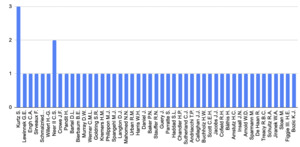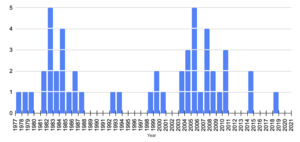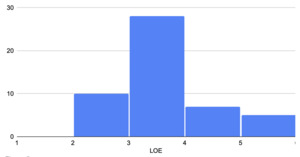Introduction
Clinical research is the foundation on which medicine is carried out and ultimately evolves. Medical advancement lends itself to the development of specialized scientific journals to efficiently categorize studies into their respective domain. There are many reputable scientific journals responsible for publishing studies corresponding to orthopaedics. Perhaps one of the most influential and prestigious orthopaedic journals is The Journal of Bone and Joint Surgery (JBJS). In 2015, JBJS had the highest Impact Factor (IF) among orthopaedic journals for the second consecutive year. Of the many topics covered under the JBJS umbrella one of the, if not the most, influential topic is that of total joint replacements (TJR). In fact, from 2013-2014 the three most cited JBJS articles pertained to TJR.
The importance of TJR research parallels it’s high prevalence in American society. Over one million total hip and knee replacements are performed each year in the US.1 It is even estimated that half of adults diagnosed with osteoarthritis (OA) in America will eventually undergo a total knee replacement.2 While in the past OA was seen as a disease process that exclusively inflicted the elderly, recent studies may show something entirely different. Recent trends have shown that young patients (age <65) will represent more than 50% of all primary and revision total joint replacements by 2030.3
The purpose of this study is to conduct a bibliometric review on the most influential TJR studies published in JBJS. Bibliometric reviews involve the process of using the number of citations a study has amassed since its publication in order to extrapolate its influence. By doing so, we hope to identify the extent of published research pertaining to TJR while simultaneously gauging any trends that may be present in modern studies. Such analysis will provide a baseline for future research and medical development.
Methods
The Scopus database was used for this study to gather the relevant data. A search query conducted in November of 2021 including Source Title: “The Journal of Bone and Joint Surgery” AND topic: “Total joint replacement OR arthroplasty” yielded a total of 3,219 publications. These results were refined to include only publications which were classified as “articles” or “reviews”, in the final publication stage, and available in English. The results were then sorted by total number of citations, from highest to lowest. Information including the institution of origin, country of origin, number of publications by year, and number of publications by author was then collected, using features of the Scopus database. All the information was extracted from the Scopus database and placed into a spreadsheet to allow for further analysis of the 50 most highly cited publications.
The full-text of each of the 50 most highly cited publications was manually analyzed to determine the appropriate publication classification and level of evidence (LOE). The manual analysis was conducted by two of the authors (Joseph Costello and Jonathan Weinerman), who each operated independently. The LOE classification used was in accordance with the University of Oxford’s Evidence-Based Medicine guidelines. The guidelines for LOE are:
1 = Systematic reviews of randomized trials, or systematic reviews of inception cohort studies.
2 = Systematic reviews of cohort studies, inception cohort studies, cross-sectional studies, randomized trials, or observational studies with dramatic effect.
3 = Cohort studies (primarily retrospective), epidemiological/observational study
4 = Case-control studies, low impact cohort studies, animal trials
5 = Simulations, models, or mechanism-based reasoning
Publications were classified into the following categories: clinical outcomes, surgical technique, anatomy and physiology, imaging, technical note, clinical guidelines, etiology, epidemiology, implants, economics, future projections, and patient perceptions. Publications which fit into multiple categories were tagged with multiple classifications as appropriate.
Results
The top 50 publications analyzed for this study were cited a total of 35,850 times (including self-citations). The average number of citations from this grouping was 717 citations per article. The most cited article among this group amassed a total of 5149 citations, while the least cited article still managed to achieve 401 citations. The oldest publication from the top 50 was from 1977, with the most recent article being published in 2018 (Table 1).
Two authors contributed more than one publication to the top 50 (Kurtz = 3, Neer II = 2). All other authors each contributed one publication (Figure 1). There was a bimodal distribution for years of publication, with the first peak occurring in 1982 and the second peak occurring in 2005. Those two years respectively each saw five publications. 1984 and 2007 followed with four publications in each of those years. The years 2004 and 2010 each contributed three publications to the top 50. The journal’s least cited stretch of years ranged between 1988 and 2003, during which only five of the top 50 articles were published (Figure 2).
Five countries stood out with multiple publications to the top 50 articles. The United States, by far, contributed the most with a total of 34 of the top 50 articles. The United States was followed by England with seven, Germany with three, and Canada and France both with two (Figure 3). The top five institutions contributing to the top 50 articles were all located within the United States. The most prolific contributing university was Harvard University with eight publications, Massachusetts General Hospital with eight, New York Presbyterian hospital with five, Mayo Clinic with four, and Rush University with four (Figure 4).
Out of the 50 articles analyzed, most publications met the criteria for Level III in terms of Level of Evidence (LOE) with a total number of 28 papers. There were 10 papers categorized as Level II evidence, seven papers categorized as Level IV evidence and five papers categorized as Level V evidence (Figure 5). It is worth noting that no papers met the criteria for level one evidence which is composed of mostly systematic reviews or meta-analyses of randomized control trials. All the publications met specific criterion for level of evidence, and none were left uncategorized. In terms of classification, the most common article category was outcomes (Figure 6). With respect to classifying the publications, the most common classification was tied between Devices/Implants and Clinical Outcomes with a total of 21 publications for each classification. There were 16 publications that shared a dual classification of both of these categories. The third most common classification was described as Anatomy/Biomechanics/Physiology, which totaled 10 publications. It is worth noting that some publications spanned multiple categories of classification. Those which encompassed multiple classifications were included in the total count, once for each classification. All publications fell within our classification system and none of the publications analyzed went unclassified at the end of the analysis (Figure 6).
The four most cited articles in this study amassed over 1000 citations each period the most cited article was “Projections of primary and revision hip and knee arthroplasty in the United States from 2005 to 2030,” (2007) by Kurtz, et al. this study formulated projections for the number of primary and revision total hip and knee arthroplasties that will be performed in the United States through 2030. “Dislocations after total hip-replacement arthroplasties,” (1978) by Lewinnek, et al was the second most published article in the top 50. The authors of this study assessed postoperative dislocations with specific and precise measurements, along with other risk factors for dislocation. The third most cited article in the top 50 was “Porous-coated hip replacement. The factors governing bone ingrowth, stress shielding, and clinical results,” (1987) by Engh, et al, which evaluated porous- coated cobalt-chrome femoral implants in patients at two and five year intervals and assessed bone ingrowth along with other clinical outcomes and sequela. “Grammont inverted total shoulder arthroplasty in the treatment of glenohumeral osteoarthritis with massive rupture of the cuff. Results of a multicentre study of 80 shoulders,” (2005) by Sirveaux, et al was the 4th most cited publication. This study quantified the procedural rate and revision burden of total hip and knee arthroplasty in the United States and looked to determine if age or gender-based procedural rates and overall revision burden were changing overtime (Table 1).
After the top 50 articles were ranked by total citation number, they were resorted based on the number of citations accrued per year since their publication date. This filter left the aforementioned, Kurtz, et al, in the top position, with an average of 343 citations per year, more than triple of the next publication. Sloan, et al’s “Projected Volume of Primary Total Joint Arthroplasty in the U.S., 2014 to 2030,” (2018) followed with an average of 102 citations per year since publication. It is worth noting that aside from the single most cited publication (Kurtz, et al- 2007), the majority of the overall most cited publications were replaced by articles from 2005 and on, which on average, amassed more citations per year (Table 2).
Discussion
Our analysis provided evidence that total joint replacement is a prominent topic of interest in the field of orthopaedic surgery. Just from JBJS alone, the top 50 most influential articles pertaining to TJR were cited over 30,000 times. Being that JBJS is one of the most influential and renowned orthopaedic journals in the world, only adds to the importance of the topic. The interest in this topic has also spanned several decades. The oldest publication in our analysis was released in 1977 and the most recent study was published in 2018. As our results also showed, there was a large incidence of TJR publications noted in the 1980’s that was only matched by the spike seen in the 2000’s. One might assume that there will be similar spikes to be seen in the future due to the rapidly growing incidence of total joint replacements.
Two of the most influential publications assessed in this study were both focused on projecting the massive growth of joint replacements in the near future. Firstly, Kurtz, et al’s 2007 study, “Projections of primary and revision hip and knee arthroplasty in the United States from 2005 to 2030”, was the most cited publication in our study, both in terms of total citations and citations per year since its publication. The researchers estimated giant leaps in growth for both total hip and knee arthroplasties. Specifically, the researchers expect to see a 174% increase in primary total hip arthroplasties and a 673% increase in primary total knee arthroplasties. They also expect to see total hip and knee arthroplasty revisions to more than double in the same time frame.
The second most influential publication in our study, in terms of number of citations per year since its publication, Sloan, et al’s, 2018 study, “Projected Volume of Primary Joint Arthroplasty in the U.S., 2014 to 2030”, similarly sought to look at the estimated growth of TJA in the United States. The main difference being that it’s a reassessment a decade or so later. These newer projections saw a slightly higher incidence of primary hip replacements compared to Kurtz, et al. (635,000 vs 572,000 procedures) but an estimated lesser growth of primary total knee replacements (1.26 million vs 3.48 million procedures). Regardless, both studies confirm that there has been and will likely continue to be a steady increase in the number of TJR in the United States over the next decade or more.
The Organization for Economic Co-operation and Development (OECD), a global coalition focused on providing evidence-based international data to improve policies, recently published a study on hip arthroplasty projections much like the two aforementioned studies.4 Their study analyzed growth rates on a country-by-country basis. They noted that The United States is expected to contribute 56% of the world’s total hip replacements by 2050. Additionally, The United Kingdom, along with the US and three other countries, contribute 75% of all implants (currently and in the future). It’s perhaps no surprise then, that the two countries that have contributed the most to the field of TJR, via publications in JBJS, are The United States and The United Kingdom.
Conclusion
As one of the most distinguished scientific journals, it’s no wonder that JBJS has published such influential literature on TJR. With over 30,000 citations spanning over four decades, this bibliometric review highlights the impact that JBJS has had on the literature distribution of TJR. A tremendous amount of effort has gone into studying the projected growth of total knee and hip arthroplasties, further emphasizing that this topic will continue to be a mainstay of orthopaedic surgery for years to come.
Acknowledgments
None
Author Contributions
All authors participated in the study and helped shape the research question, data, analysis, and manuscript.
Conflicts of Interest and Source of Funding
The authors, their immediate family, and any research foundation with which they are affiliated did not receive any financial payments or other benefits from any commercial entity related to the subject of this article. There are no relevant disclosures. We have no conflicts of interest. All authors significantly contributed to the document and have reviewed the final manuscript.












